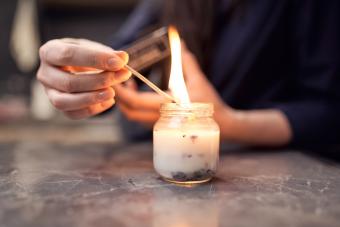
Learn how to clean a wooden cutting board in a few simple steps. Get tips for cleaning mold and sticky residue on your wooden cutting board. And find out the benefits of a plastic vs. wooden cutting board.
How to Care for a Wooden Cutting Board
When it comes to caring for your wooden cutting board regularly to avoid warping or ruin, it's pretty simple. You only need a few essential cleaning products.
-
Dish soap (Dawn works best)
-
Salt
-
Cloth
-
Scouring pad
-
Board oil (mineral oil or beeswax)
-
Lemon
-
Baking soda
How to Clean a Cutting Board With Dish Soap
After using your cutting board, you need to clean it. This doesn't mean you want to throw it in a sink of soapy water. Cutting boards can warp if they absorb too much water, so rather than that, grab a cloth and dish soap.
-
Work a drop of dish soap into a cloth.
-
Wipe down all sides of the cutting board.
-
Rinse under warm water.
-
Dry completely before putting away.

How to Clean and Cut Stains on a Cutting Board With Lemon
Rather than using dish soap, you can also use a bit of lemon and salt to clean your cutting board. In addition to cleaning, this helps to remove odors. This is a great method to use after cutting raw meat.
-
Half a lemon.
-
Sprinkle salt on the cutting board.
-
Rub the lemon wedge over the board.
-
Let the solution sit for 5 minutes.
-
Wash off with soap and water.
-
Rinse and dry.
How to Sanitize a Cutting Board With White Vinegar
When it comes to cleaning your cutting board, white vinegar can also be a good cleaner and deodorizer.
-
Soak a cloth in a 1:1 ratio of white vinegar and water.
-
Wring it out slightly and place it over the cutting board. (Make sure to get it on the dirty part.)
-
Allow it to sit for 5 minutes.
-
Scrub the board completely with the cloth.
-
Rinse and dry.
Oiling a Wooden Cutting Board
When you first get a wooden cutting board, you need to season it with mineral oil, beeswax, or another approved food safe oil. To do this, you just need to put the oil on a cloth and rub it in a circular fashion. Allow it to sit for about 24 hours and wipe off excess. This should also be done every month to keep your wooden cutting board looking new.
How to Clean Wooden Cutting Board Mold and Mildew
Mold is a common problem for some cutting boards. It's not something you did wrong; the wood just absorbed some water, and storage made optimal mold growing conditions. To remove mold, you have a few options. You can try bleach, hydrogen peroxide, or white vinegar.
How to Clean Mold on a Wooden Cutting Board With White Vinegar
A chemical-free way to eliminate mold on your wooden cutting board is through white vinegar.
-
Put a 1:1 mixture of white vinegar and water on the mold.
-
Allow it to sit for 5 minutes.
-
Dip a wet cloth in baking soda and scrub.
-
Rinse and dry.
How to Clean Mold With Bleach
When it comes to cleaning mold with bleach, think less is more.
-
Mix a solution of 1 teaspoon of bleach in 8 cups of warm water.
-
Rub the solution on the mold.
-
Rinse and dry.
How to Clean Mold With Hydrogen Peroxide
An alternative to the bleach for a mold problem on your wooden cutting board is using hydrogen peroxide.
-
Put straight hydrogen peroxide on a cloth.
-
Rub it over the mold.
-
Repeat for stubborn mold.
How to Clean a Sticky Wooden Cutting Board
When it comes to sticky stains on your wooden cutting board, reach for baking soda or salt. These two can quickly cut through the yuck to leave your board shining.
-
Create a paste with baking soda and water.
-
Put the paste on the sticky area.
-
Allow it to sit for about 5 minutes.
-
Work the area with a damp cloth.
-
If the sticky still lingers, pour a bit of salt on the area.
-
Scrub in circular motions with a damp cloth.
Wood Cutting Boards vs. Plastic Cutting Boards
When it comes to your cutting board, people land on both sides of the plastic vs. wood debate. However, both have their pros and cons.
Wooden Cutting Boards Pros and Cons
When it comes to wood, you can find some great pros and a few cons. Just take a look:
-
Last a long time
-
Traps and kills bacteria
-
Gentle to knives
-
Beautiful to look at
-
Requires upkeep like seasoning and sanding
-
Harder to clean
Plastic Cutting Board Pros and Cons
Just like your wooden cutting board, plastic cutting boards have pros and cons to using them. A few of these include:
-
Cheap to buy and replace
-
Lightweight
-
Dishwasher cleaned
-
Harder than wood on knives
-
Need replacing more often
Getting the Perfect Cutting Board
Cleaning your wooden cutting board is pretty easy. You just need to make sure you keep them up, so they last a lifetime in your kitchen, and to make sure your cutting board isn't added to the dirtiest places in your house. While you're working in your food prep areas, you should also get some tips on how to clean sticky wood kitchen cabinets.







